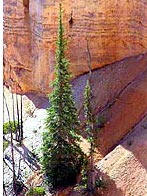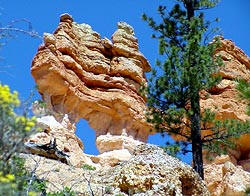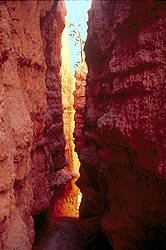|
WILDLIFE
Bryce Canyon is known for its incredible geology and
sweeping vistas, but equally impressive are the animals that make the
uplifted plateaus of Utah such a unique environment.
Bryce Canyon is home to 59 species of mammals.
Mammals are classified as higher vertebrates that have hair and nourish
their young with milk secreted by mammary glands. Viewing mammals is a
favorite activity of another mammal we know as humans, and Bryce is great
place to see a lot of different kinds of mammals.
Some of the more common mammals in the Park include
the
Golden-mantled Ground Squirrel,
Mountain Lion, Pronghorn Antelope,
Uinta Chipmunk, and
Utah Prairie Dog.
Birds are feather vertebrates, most having flight
capability, that reproduce from hard-shelled eggs. While everybody knows
what a bird is, few think of Bryce Canyon when they think about birds.
Nevertheless, 175 different species of birds have been documented to
frequent Bryce Canyon National Park. Some are just passing through. Others
stay for an entire season. Fewer still make this their year round home.
More information on the Park's birds is available on the National Park
Service website.
Finally, 11 species of reptiles and four species of
amphibians can be found at Bryce.
FLORA
 Surrounded by
deserts, Bryce's highland plateau gets much more rain than the lowlands
below and stays cooler during hot summers. The relatively lush ecosystems
that result are like fertile islands towering above a vast arid landscape. Surrounded by
deserts, Bryce's highland plateau gets much more rain than the lowlands
below and stays cooler during hot summers. The relatively lush ecosystems
that result are like fertile islands towering above a vast arid landscape.
Trees include Blue Spruce, Bristlecone Pines,
Douglas-fir, Limber Pine, Pinyon Pine, Ponderosa Pine, Quaking Aspen and
Rocky Mountain Juniper.
For more information,
visit the National Park Service website.
GEOLOGY
 Arches or windows are
natural holes that form along cracks and weak spots in thin walls of rock
called "fins." By
convention these holes must be at least 3 feet in diameter in two
perpendicular directions to earn the name arch or window. An imprecise
distinction is often made between bridges and arches in terms of the
processes that form them. It's important to remember that gravity is the
key factor in either case. Nevertheless, the distinction is that bridges
are carved by flowing water, whereas arches can be carved by everything
else except flowing water. Indeed, in very few circumstances is it
possible to say that flowing water had zero contribution in the
development of one of these natural holes. Therefore, geologists often
prefer the term window to collectively describe any large hole in a rock.
At Bryce Canyon most of our windows are carved by frost wedging. Arches or windows are
natural holes that form along cracks and weak spots in thin walls of rock
called "fins." By
convention these holes must be at least 3 feet in diameter in two
perpendicular directions to earn the name arch or window. An imprecise
distinction is often made between bridges and arches in terms of the
processes that form them. It's important to remember that gravity is the
key factor in either case. Nevertheless, the distinction is that bridges
are carved by flowing water, whereas arches can be carved by everything
else except flowing water. Indeed, in very few circumstances is it
possible to say that flowing water had zero contribution in the
development of one of these natural holes. Therefore, geologists often
prefer the term window to collectively describe any large hole in a rock.
At Bryce Canyon most of our windows are carved by frost wedging.
The Grand Staircase is an immense sequence
of sedimentary rock layers that stretch south from Bryce Canyon National
Park through Zion National Park and into the Grand Canyon. In the 1870s,
geologist Clarence Dutton first conceptualized this region as a huge
stairway ascending out of the bottom of the Grand Canyon northward with
the cliff edge of each layer forming giant steps. Dutton divided this
layer cake of Earth history into five steps that he colorfully named Pink
Cliffs, Grey Cliffs, White Cliffs, Vermilion Cliffs, and Chocolate Cliffs.
Since then, modern geologists have further divided Dutton's steps into
individual rock formations.
What makes the Grand Staircase worldly unique is
that it preserves more Earth history than any other place on Earth.
Geologists often liken the study of sedimentary rock layers to reading a
history book--layer by layer, detailed chapter by detailed chapter. The
problem is that in most places in the world, the book has been severely
damaged by the rise and fall of mountains, the scouring of glaciers, etc.
Usually these chapters are completely disarticulated from each other and
often whole pages are just missing. Yet the Grand Staircase and the lower
cliffs that comprise the Grand Canyon remain largely intact speaking to
over 600 million years of continuous Earth history with only a few
paragraphs missing here and there.
Hoodoos are tall skinny spires of rock that
protrude from the bottom of arid basins and "broken" lands. Hoodoos are
most commonly found in the High Plateaus region of the Colorado Plateau
and in the Badlands regions of the Northern Great Plains. While hoodoos
are scattered throughout these areas, nowhere in the world are they as
abundant as in the northern section of Bryce Canyon National Park. In
common  usage, the
difference between Hoodoos and pinnacles or spires is that hoodoos have a
variable thickness often described as having a "totem pole-shaped body." A
spire, on the other hand, has a more smooth profile or uniform thickness
that tapers from the ground upward. usage, the
difference between Hoodoos and pinnacles or spires is that hoodoos have a
variable thickness often described as having a "totem pole-shaped body." A
spire, on the other hand, has a more smooth profile or uniform thickness
that tapers from the ground upward.
At Bryce Canyon, hoodoos range in size from that
of an average human to heights exceeding a 10-story building.
Walls or fins are narrow walls of rock,
bound by joints or fractures on either side. As weathering and erosion
opens the cracks wider and wider they form narrows or slot canyons. The
wall left standing in between two slot canyons is called a fin. As fins
develop, differential erosion accentuates different rock hardness leaving
them with a rugose appearance.
|

